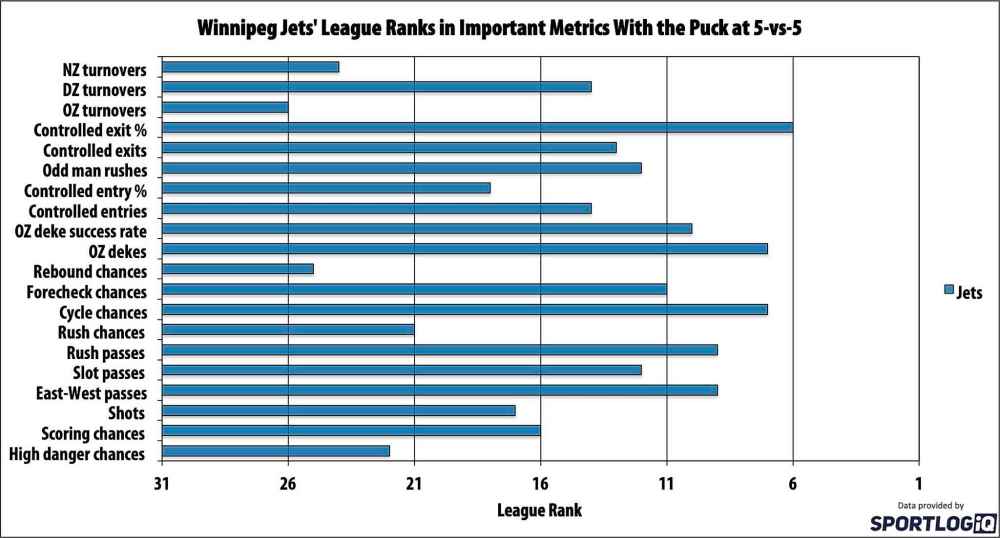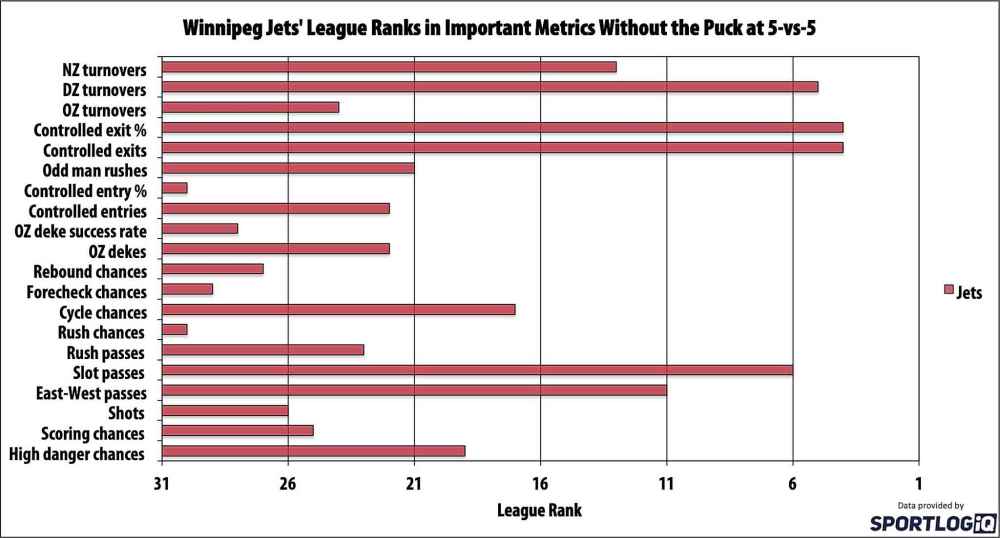Jets’ leaky ship not built for success in NHL’s rough playoff waters
Advertisement
Read this article for free:
or
Already have an account? Log in here »
To continue reading, please subscribe:
Monthly Digital Subscription
$0 for the first 4 weeks*
- Enjoy unlimited reading on winnipegfreepress.com
- Read the E-Edition, our digital replica newspaper
- Access News Break, our award-winning app
- Play interactive puzzles
*No charge for 4 weeks then price increases to the regular rate of $19.00 plus GST every four weeks. Offer available to new and qualified returning subscribers only. Cancel any time.
Monthly Digital Subscription
$4.75/week*
- Enjoy unlimited reading on winnipegfreepress.com
- Read the E-Edition, our digital replica newspaper
- Access News Break, our award-winning app
- Play interactive puzzles
*Billed as $19 plus GST every four weeks. Cancel any time.
To continue reading, please subscribe:
Add Free Press access to your Brandon Sun subscription for only an additional
$1 for the first 4 weeks*
*Your next subscription payment will increase by $1.00 and you will be charged $16.99 plus GST for four weeks. After four weeks, your payment will increase to $23.99 plus GST every four weeks.
Read unlimited articles for free today:
or
Already have an account? Log in here »
Hey there, time traveller!
This article was published 29/03/2019 (2450 days ago), so information in it may no longer be current.
The 2018-19 NHL regular season is coming to a close and the Winnipeg Jets are preparing for the playoffs as a likely division winner and an expected Stanley Cup contender. However, those who have watched this team all season long know there are some issues that need to be ironed out if the Jets hope to make a serious run.
With just a week left, it’s an appropriate time to go over the Jets’ strengths and weaknesses in depth. To get a feel for the team’s performance over time, here’s a glance at their control of shot volume and shot quality at even-strength each month of the season.

!function(e,t,s,i){var n=”InfogramEmbeds”,o=e.getElementsByTagName(“script”)[0],d=/^http:/.test(e.location)?”http:”:”https:”;if(/^/{2}/.test(i)&&(i=d+i),window[n]&&window[n].initialized)window[n].process&&window[n].process();else if(!e.getElementById(s)){var r=e.createElement(“script”);r.async=1,r.id=s,r.src=i,o.parentNode.insertBefore(r,o)}}(document,0,”infogram-async”,”https://e.infogram.com/js/dist/embed-loader-min.js”);
Unfortunately for the Jets, this is not the kind of thing you want to see at the end of the season, and the collapse against the New York Islanders on Thursday night is indicative of a problem that has been festering since January; the Jets have collapsed defensively.
There are mitigating factors to take into account here; the loss of Dustin Byfuglien and Josh Morrissey compound already-existing defensive issues, but with the talent on the roster overall, the Jets should not be a team that is getting 42.8 per cent of the scoring chances at five-on-five. They’re simply better than that.
The Jets’ offence has been relatively consistent all season long at even-strength, but their defence has dropped off in each of the last three months. I’m all for the idea of teams with very little chance of missing the playoffs coasting to the finish line to rest up for the ultimate grind of the post-season, but you want to see some signs of life at the end of the season, as well. Looking at how the Jets are trending in shots, it’s a little worrying.
However, we can’t just leave things at shots, so let’s look at how the Jets rank relative to the rest of the league in a variety of other statistics. First off, we’ll look at the Jets with the puck.
There’s a lot of information to look at here, but the most important thing to know is that the higher the ranking up to first, the better the Jets are performing in each metric.
Of the 20 metrics I’ve chosen here, the Jets are above league average in 12 of them and at league average in another, which sounds good, but for a team expected to be a cup contender, it’s not all that impressive.
The biggest strengths the Jets have with the puck are their smooth exits out of the defensive zone with control as opposed to dumping the puck off the boards and out, their ability to create scoring chances off the cycle, east-west puck movement, beating opponents with dekes in the offensive zone and puck movement off the rush.
Their biggest weaknesses are turnovers in the neutral and offensive zones, not being aggressive enough on rebounds to create second chances, turning their controlled entries into scoring chances off the rush, and generating high-danger chances.
A lot of these even-strength weaknesses are compensated for on the power play, but there are, usually, fewer penalties called in the playoffs, so relying on that can be a dangerous game.
I was a bit surprised that the Jets didn’t rank within the top-five by any measure, as last season they completed the fourth-most passes to the slot, the most east-west passes and the second-most offensive-zone dekes. That combination of beating players one-on-one and playmaking ability made the Jets one of the league’s most dangerous offensive teams, and while the talent level they possess can get them back there at any given moment, the consistency hasn’t been there this year.
Despite the plethora of offensively talented forwards though, the Jets’ true strength last season was their play without the puck. How do they fare in that regard?
Without the puck, the Jets are truly a Jekyll-and-Hyde team; they rank at or inside the top 10 in forcing defensive-zone turnovers by opponents, not allowing them to make controlled exits and forcing them to attempt dump-outs instead of clean exits, which means they can create a lot of havoc in the opponents’ defensive zone by controlling the puck for extended periods of time.
Just like puck movement is a strength for the Jets offensively, that’s where their own defensive strength lies, as opponents have great difficulty moving the puck into the slot with passes, or moving the puck across the ice down low. If you’re attacking the Jets and trying to create scoring chances, your only realistic option is to play a north-south game.
However, outside of those areas of extreme strengths, the Jets end up below league average in 14 of the 20 metrics, ranking next-to-last in giving up the blue line and, consequently, scoring chances off the rush.
The Jets have also seen their dominance on the cycle wither away over the last few months to the point where they’re slightly below league average, and they’ve been a vulnerable team on forechecks all season long.
Combine the Jets’ willingness to give up the blue line — they leave the widest gap in the NHL — with their propensity for being beat one-on-one with dekes, and you’ve got a team that simply bleeds far too many dangerous chances against, forcing their goaltenders into phenomenal performances in order to get wins when the Jets’ own offence stagnates.
With Byfuglien and Morrissey healthy, and a renewed focus when the playoffs begin, the Jets team of last year could easily pop up seemingly out of nowhere and go on a run, but as the season drags on, we’re not seeing the signs of it.

Andrew Berkshire
Andrew Berkshire is a hockey writer specializing in data-driven analysis of the game.
Our newsroom depends on a growing audience of readers to power our journalism. If you are not a paid reader, please consider becoming a subscriber.
Our newsroom depends on its audience of readers to power our journalism. Thank you for your support.



